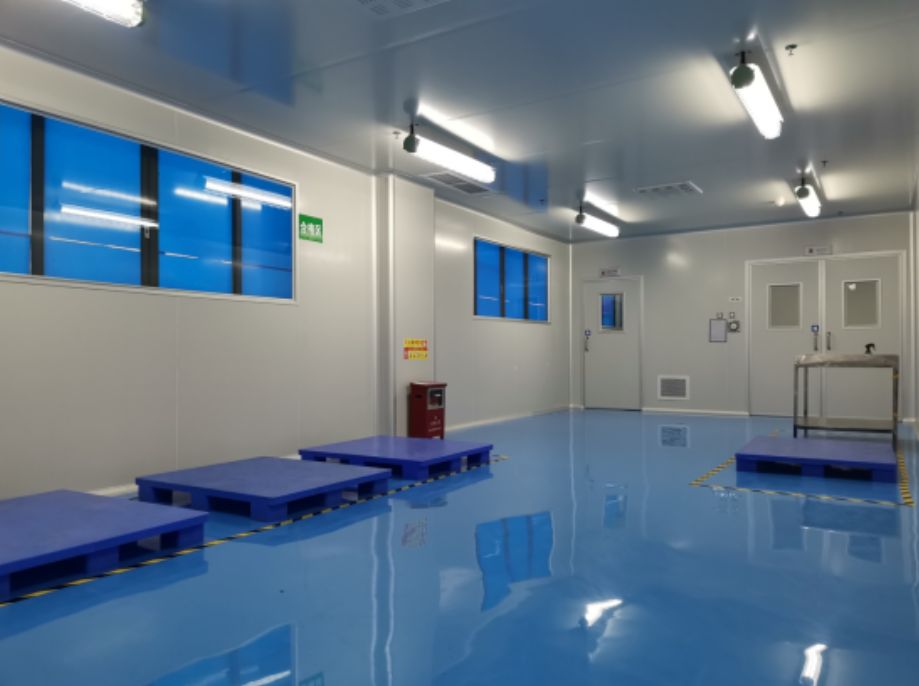GMP clean room is at the core of product production and directly affects product quality. Generally speaking, the design, construction and operation of a GMP clean room should minimize the interference and impact of the surrounding environment on the interior space of the clean room, and pressure difference control is the key to maintaining the cleanliness level of the clean room, reducing external pollution, and preventing cross-infection. Therefore, the air tightness of doors and windows in the design and decoration of GMP clean rooms such as cosmetics GMP purification workshops, food QS dust-free workshops, pharmaceutical GMP purification workshops, and electronic dust-free workshops is particularly important.
1. Treatment of gaps in clean room doors and windows Generally speaking, most clean room doors and windows have three types of structural gaps.
One type is the combined splicing of the studs and the installation gap between the studs and the door opening of the clean room;
The second category is the lap gap between the shank and the opening fan;
The third category is the installation gap of glass or other core boards.
The air leakage of the clean room door that is usually mentioned is nothing more than a problem caused by the above three gaps.
Among these three kinds of structural gaps, the first and third types belong to fixed gaps, and the second type belongs to movable gaps, which have different properties and their proportions on clean room doors and windows are also different. Therefore, the airtight measures taken to seal the doors and windows of the clean room are not exactly the same, which is also an important step in the dust-free evolution project.
(1) Treatment of fixed gaps The installed gaps are not only relatively small in the number of doors and windows in each clean room, but also the combination of the studs and the openings is relatively concealed after decoration, and it is a fixed gap that is easier to seal.
The connection between the edge and the periphery of the hole should be firm, not only the airtight clean room doors and windows, but also the requirements of the general clean room door structure. Due to the large and fierce force on the clean room door, special attention should be paid to the distance and its distance when fixing the clean room door. Whether the fixed points around the opening are firm and stable, but for the doors and windows of the airtight clean room, it must also be emphasized that the gap between the bore and the door opening or spacer of the clean room must be filled tightly, and then covered with indoor and outdoor wall decoration layers. To ensure the air tightness of this type of gap, the second type of fixed gap is the installation gap of glass or other core boards.
The proportion of the number of gaps in the clean room door is relatively small, but it is often the main part in the structural gaps of a universe, especially for the outside world, they are exposed to the atmosphere and are affected by the outdoor climate, so be careful To deal with it, on the one hand, it is necessary to minimize the installation gap of the core glass, and on the other hand, it is necessary to carefully select the fortification structure.
(2) Handling of active gaps How to overlap the opening fan and frame material of the clean room door is the key to the seal design of the clean room door. The gap at the lap joint is different from the fixed gap, because the movable fan needs to be opened and wood can take “once and for all” sealing measures.
Compared with Zhou, the opening leaf of the clean room door is larger, and the movable gap occupies a larger proportion in the total number of structural gaps of a clean room door. The working conditions of the gaps around the door leaf are also more complicated. Taking the single-leaf flat-opening clean room door as an example, the two sides along the vertical direction are small. The direction of the force applied to the chamber due to the rotation of the fan is completely different from the other three sides. The threshold of the clean room must be specially constructed according to the different requirements of transportation and pedestrian traffic. Generally, three of the four side gaps of the single-leaf clean room door need to be treated differently, and the middle gap of the double-leaf clean room door is also of a special structure. Therefore, the sealing treatment of the movable gap is a more prominent problem in the design of the clean room door. The notch size and notch form of the overlap between the opening fan and the frame material are important issues that must be paid attention to in the design of the movable gap seal.
The four factors of village bureau, frame, hardware, airtight strip and its mode of action should be considered comprehensively, so that they can coordinate with each other in terms of structure and stress state, and achieve the purpose of sealing. It should be pointed out that the door leaf of the clean room is larger and heavier than the window leaf, and the force applied when sealing and pressing is much greater, especially when it is always opening and closing and rotating continuously, so it is necessary to control the sagging of the clean room door leaf and ensure the rigidity of the clean room door leaf. Let’s focus on the selection of hardware.
2. The gap sealing of the door leaf of the flat-opening clean room The flat-opening airtight clean room door is the most used type of clean room door in the clean workshop. It is usually used for traffic or transportation, and it is very convenient for emergency evacuation in case of fire.
Generally, the elastic material of the formed section is used as the airtight strip to fix and seal at the seam. The opening width of commonly used clean room doors is mostly below 1800mm for double-leaf inner clean room doors, and mostly below 2100mm for double-leaf outer clean room doors; the height of the opening is generally within 2400mm.
The setting of airtight strips, in the case of frequent opening and closing of the clean room door leaves, except for some clean room doors may be placed on the clean room door leaf on the collision surface of the clean room door tower in order to avoid heavy equipment and other transportation. , or some inner clean room doors are not allowed to set the clean room threshold on the ground due to workshop transportation, and can only be installed on the bottom of the clean room door leaf near the ground. , foot or car collision, less affected by pedestrians and transportation, and more elastic airtight strips with a small section of a few millimeters in length and width are laid on the hidden groove of the clean room door handle, and then compressed by the closing of the clean room door leaf .
The airtight strip should be laid continuously along the periphery of the movable gap, so as to form a closed ring-shaped sealing line after the clean room door is closed. When the airtight strips are respectively set at the clean room door tower and the clean room door leaf, attention must be paid to the good connection of the pottery, and the small gap between the airtight strips at the clean room door seam should be minimized as much as possible.
Guangdong Qianqin Purification Technology Co.,Limited mainly produces clean room doors/window,air shower, pass box, ffu,laminar air flow, hepa filter box,etc since 2011, Please feel free to send us your enquiry at brad.su@qh-puritech.com.
Post time: Dec-13-2022

 +86-18038493642
+86-18038493642
